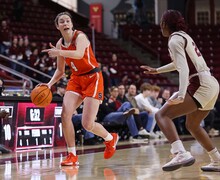Renowned painter Arnaldo Roche Rabell to showcase at Point of Contact Gallery
Photo courtesy of Point of Contact Gallery
The exhibit, "The Blue of Ruin," is named after the factor that every painting in the gallery features the color blue.
Famous Puerto Rican artist Arnaldo Roche Rabell will be showcasing his exhibit, “The Blue of Ruin,” at the Point of Contact Gallery on Thursday evening. The exhibit highlights his experiments with rubbing and scraping through still life and portraits.
“I’m an artist that deals with reality,” Rabell said. “(This exhibit) allows me to express myself through the process of touching.”
Plans for this exhibit began over a year ago, as the gallery began looking for new contemporary and experimental international artists to feature, said Miranda Traudt, the gallery’s managing director.
Tere Paniagua, the executive director of the Office of Cultural Engagement for the Hispanic Community and one of the individuals that helped bring Rabell in, described him as a “rock star in his own right.” Paniagua, who is also Puerto Rican, said he sees the potential Rabell’s work could have on the Latin community in Syracuse.
“(Rabell) feels very strongly about connecting with that community in Syracuse,” she said. “It’s very exciting to be presenting this show.”
Photo courtesy of Point of Contact Gallery
After selecting Rabell, Point of Contact selected the different pieces to be featured in the gallery. They arranged for the shipment of his work and named the exhibit after his use of blue in every piece. Rabell said after living through a tsunami, he began to paint everything in blue, seeing shades of blue in everything. He said he liked how the “consciousness” of these pieces made those circumstances very textual.
Rabell spent this week at the gallery working with the curator to decide where everything should be placed in the exhibition. Some of the pieces will be the largest the gallery has ever presented, the biggest at 15 feet long and 12 feet high.
As for the work itself, most of Rabell’s pieces involve portraits of family and friends, exploring memory and personal experience. He said he has constantly struggled with the problem of existence, and he hopes through his work, he will be able “to be aware that others exist and to be comfortable with myself.”
After graduating from the school of architecture at Universidad de Puerto Rico, Rabell moved to Chicago to complete his master’s degree. He said that while he was there, he went through a number of religious experiences that changed his perspective on human existence and relationships.
I have a holistic view of how to be happy. I use my art to understand the emotional part of art in the case of the bodies or models, or the person behind the canvas. My art is an investigation of myself in relation to others.Arnaldo Roche Rabell
Rabell admitted that at the beginning of his career he didn’t know what he was doing at first, but he had a desire to involve history in his explanations of human life. He said he puts a large amount of love, care and respect into all of his work.
In terms of his exhibit, Rabell said he is most excited to be able to interact and expose himself and his work to others.
“I’m seeing this exhibition not as part of the process. I’m here with the veins open, letting the blood go any which way. I’m here to share, for the opportunity to engage with younger art students and the community,” he said.
Rabell will be on campus visiting with students and faculty in the painting department of the College of Visual and Performing Arts on Thursday.
The reception will feature an open bar with refreshments, and a chance for the audience to interact and speak to the Rabell, who will also give a short introduction to his work.
Traudt said she was most excited to see all the patrons come into contact with the work.
“Our mission at Contact is to bring the work of these artists from all over the world in contact with the faculty and students at SU to the community of SU,” she said. “We don’t try and tell anyone what to look for and what to find but just to create their own interpretation of the work.”
Published on March 23, 2016 at 9:11 pm
Contact Hanna: hrhorvat@syr.edu






